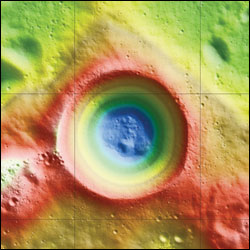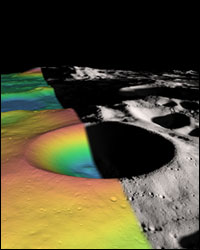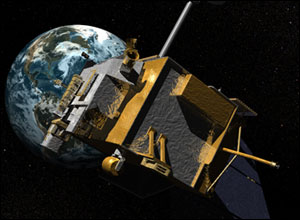WASHINGTON, June 22, 2012 — New data from NASA's Lunar Reconnaissance Orbiter (LRO) spacecraft shows that ice may make up as much as 22 percent of the surface material in the Shackleton crater on the moon’s south pole – and the finding would not have been possible without a laser.
NASA astronomers determined that the crater’s floor is brighter than those of other nearby craters, which is consistent with the presence of small amounts of ice. Such ice could prove valuable for researchers to understand crater formation and to study uncharted areas of the moon.

Elevation map of the Shackleton crater made using LRO Lunar Orbiter Laser Altimeter data. The false colors indicate height, with blue lowest and red/white highest. (Image: NASA/Zuber, M.T. et al., Nature, 2012)
"The brightness measurements have been puzzling us since two summers ago," said Gregory Neumann of NASA's Goddard Space Flight Center in Greenbelt, Md. “While the distribution of brightness was not exactly what we had expected, practically every measurement related to ice and other volatile compounds on the moon is surprising, given the cosmically cold temperatures inside its polar craters.”
The Shackleton crater, named for Antarctic explorer Ernest Shackleton, is 2 miles deep and more than 12 miles wide. Because of its location at the moon’s south pole, sunlight never reaches the floor of the crater, making it extremely cold and dark.

The structure of the Shackleton crater’s interior, shown in false
color, was constructed from over 5 million elevation measurements from
the Lunar Orbiter Laser Altimeter. (Image: NASA/GSFC/SVS)
Using LRO's laser altimeter to illuminate the crater’s interior, a team led by Maria Zuber of MIT mapped the crater with unprecedented detail by measuring the reflectivity of its floor and walls. The laser beam penetrated the surface to a depth corresponding to its wavelength — less than one ten-thousandth of an inch.
Zuber and colleagues observed that the floor of the crater was relatively bright, but the walls were even brighter. At first, this was puzzling; scientists hypothesized that if ice were to be anywhere in a crater, it would be on the floor where no direct sunlight penetrates. The team speculated that moonquakes — seismic shaking brought on by meteor impacts or gravitational tides from Earth — may have caused the crater walls to slough off older, darker soil to reveal newer, brighter soil underneath.

Artist's concept of the Lunar Reconnaissance Orbiter with an image of Earth in the background. (Image: NASA)
The ultrahigh-resolution map provides strong evidence that ice appears on both the crater’s floor and walls.
“ There may be multiple explanations for the observed brightness throughout the crater,” Zuber said. “For example, newer material may be exposed along its walls, while ice may be mixed in with its floor.”
LRO was launched in June 2009 to conduct investigations in preparation for future lunar exploration. With its primary exploration mission complete, the craft is now carrying out science experiments.
The work appeared in Thursday’s issue of Nature.
For more information, visit: www.nasa.gov/lro